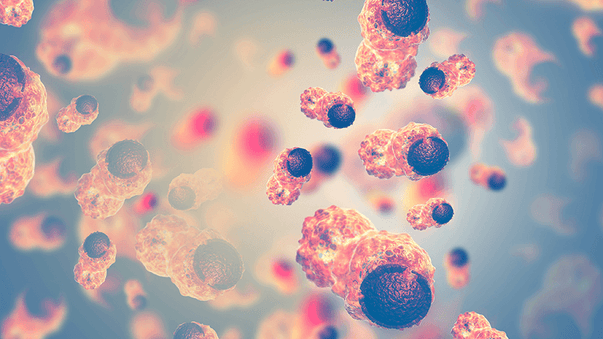Vitamin K May Prevent Abdominal Fat Accumulation

Some people assume that, as a dietitian, my children must love to eat vegetables, but each of my children have their own unique food preferences. One of my children has a hard time eating bitter foods like broccoli. As a person who is not very sensitive to bitter flavors, I had a difficult time understanding why people have such a hard time with broccoli, cabbage, and bitter greens. Promises of health and cancer prevention are rarely motivating to young children. So, alas, we follow one of the culinary tricks to reduce bitterness and melt cheese over the broccoli, or puree it into a creamy cheesy soup, to convince her that there are tasty ways to eat the vegetable.
Broccoli and leafy greens are notable for their folate and vitamin K content. Vitamin K was first known for its role in blood clotting, and the American Dietary Reference Intake (DRI) for vitamin K is based on the amount needed to maintain normal blood clotting. Vitamin K also works with vitamin D in building and maintaining strong bones. Both vitamins D and K increase calcium absorption. Vitamin D decreases calcium loss in the urine and promotes the production of proteins, like osteocalcin. Vitamin K carboxylates osteocalcin, which is involved in bone mineralization and also acts on the endocrine system. When conducting bone research, it was noticed that mice with poor vitamin K status tended to be heavier. This observation is opening up research into the role vitamin K may play in the metabolism and storage of glucose and fat.
Vitamin K may prevent abdominal fat accumulation. Vitamin K-induced effects on body fat and weight: results from a 3-year vitamin K2 intervention study. This study involved 214 postmenopausal women who were non-obese and 55-65 years of age. Participants took a placebo or 180 mcg/day of vitamin K2 (menaquinone-7, MK-7) for 3 years. They used osteocalcin carboxylation as an indicator of vitamin K status. DEXA scan was used to determine fat distribution. Over the three years of supplementation the ratio of fat mass in the android region and that in the gynoid region increased in the placebo group but not in the supplement group. Vitamin K seemed to prevent the shift of fat from the hip area to the abdominal area that often occurs post-menopause. The vitamin K group also had significantly more carboxylated osteocalcin. Greater carboxylated osteocalcin was associated with lower levels of leptin (representative of fat storage) and insulin. Those who responded the most to the vitamin K also had less abdominal fat. No significant change was seen in the inflammation marker CRP but the authors state that this may be because the participants were considered healthy to start with. The authors encouraged further investigation into how carboxylated osteocalcin influences energy metabolism and fat distribution and the potential benefits of greater supplementation.
Turmeric Curcumin may support memory and attention. Curcuma longa (Theracumin®): A Bioavailable Form of Curcumin and Its Cognitive Benefits. In this study, 20 people aged 51-84 without dementia took a placebo or curcumin 90 mg/day for 18 months. Tests were used to measure verbal memory, visual memory, and sustained attention. PET scan was used to measure amyloid plaques and tau tangles in the brain. After taking the supplement for 18 months, the group getting the curcumin supplement scored better in verbal memory, visual memory, and sustained attention. The PET scan neurodegeneration assessment showed significantly better scores for the amygdala area of the brain in the supplement group. The researchers concluded that the curcumin supplement gave memory and attention benefits to adult patients after 18 months of supplementation.
Caffeine did not improve running performance in a small study. No individual or combined effects of caffeine and beetroot-juice supplementation during submaximal or maximal running. Caffeine has shown benefit to endurance and performance in running and cycling. Nitrate rich beet juice has been shown to decrease oxygen use and improve performance in high-intensity running. This study involved 9 endurance runners. The runners were tested 5 times. The first time, VO2 max was recorded. The next four times, participants ran at 70% and 80% VO2 max for 5 min each, then ran a maximal test involving a 1 km self-paced time trial. During these 4 tests, participants were given placebos, a capsule containing 4.3-5.6 mg/kg caffeine, beet juice with 7.3 mmol of nitrate, or both. The beet juice was given 2.5 hours before warming up, and the caffeine was given 45 minutes before warming up. Unexpectedly, the researchers found no significant difference in any of the measured variables (running economy, VO2, heart rate, rate of perceived exertion, respiratory exchange rate, and performance time) with either supplement or the combination of supplements. When trying to explain why this study found no benefit to the supplements, when several studies have shown a benefit to beet juice and many studies have shown a benefit to caffeine, the researchers mentioned that higher doses or more regular use of the supplements may be needed, especially for trained athletes like those in the study. Participants were a mix of regular and non-regular caffeine users. And participants were both men and women, and the women’s menstrual cycle phase was not controlled for. Nine is also a very small number of participants when looking for statistical significance. The researchers encouraged further exploration.
More Articles
Don't fall behind! Thrivous monitors new human studies of nootropic and geroprotector supplements, so you can make the best decisions based on the latest science. Supplement Science Updates are part of the free Thrivous newsletter. Subscribe now to receive email about human enhancement, nootropics, and geroprotectors, as well as company news and deals.
Read more articles at Thrivous, the human enhancement company. You can browse recent articles in Thrivous Views. See other Supplement Science Update articles. Or check out an article below.
-
First Human Trial of Senolytics Is Successful
Senolytic drugs that target senescent cells, also covered in the previous issue of Pulse, continue to make news, with the ...
-
Rhonda Patrick's Nootropic Dietary Supplement Stack
Rhonda Patrick is a PhD in biomedical science and expert on nutritional health who runs a popular podcast. She has ...


